2001 FORD F350 belt
[x] Cancel search: beltPage 135 of 288
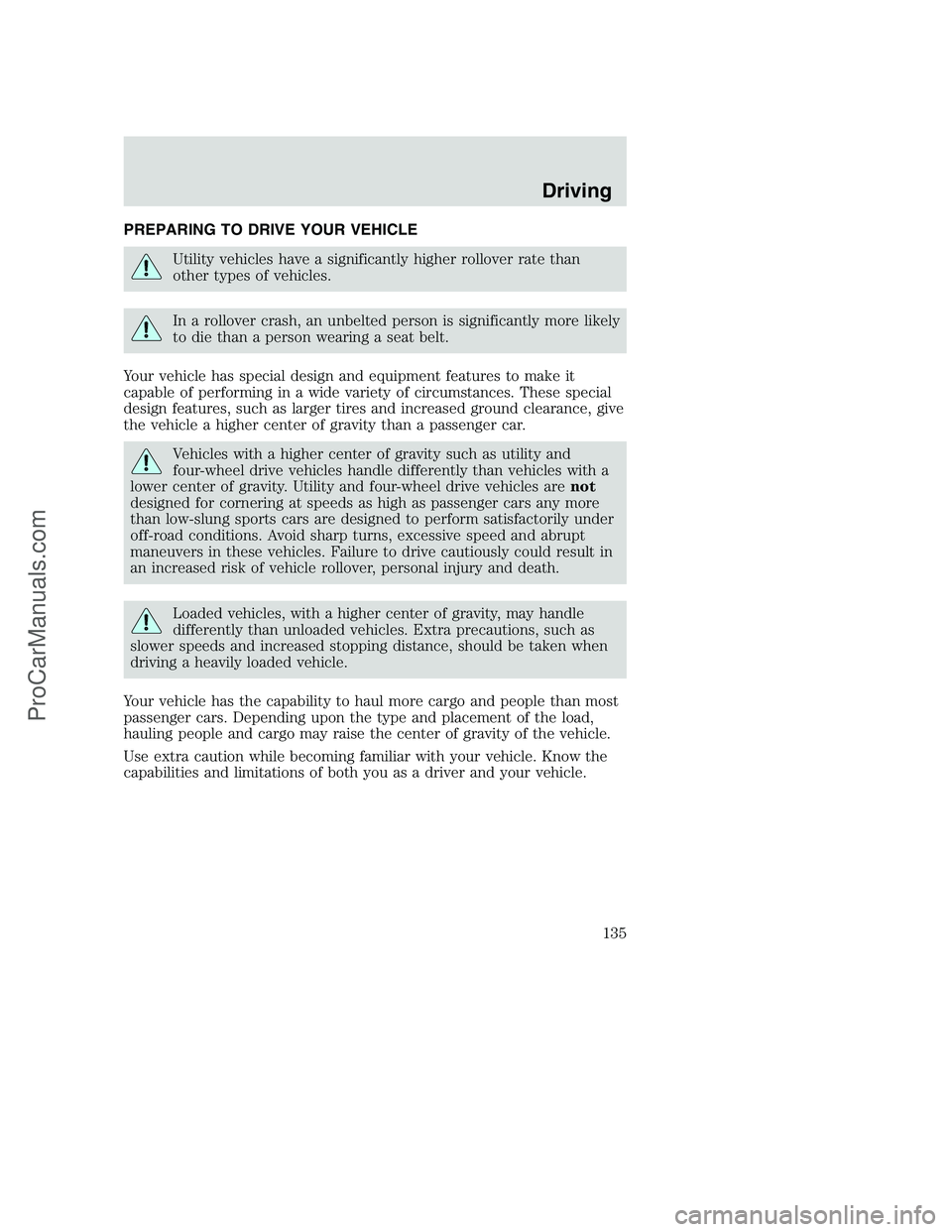
PREPARING TO DRIVE YOUR VEHICLE
Utility vehicles have a significantly higher rollover rate than
other types of vehicles.
In a rollover crash, an unbelted person is significantly more likely
to die than a person wearing a seat belt.
Your vehicle has special design and equipment features to make it
capable of performing in a wide variety of circumstances. These special
design features, such as larger tires and increased ground clearance, give
the vehicle a higher center of gravity than a passenger car.
Vehicles with a higher center of gravity such as utility and
four-wheel drive vehicles handle differently than vehicles with a
lower center of gravity. Utility and four-wheel drive vehicles arenot
designed for cornering at speeds as high as passenger cars any more
than low-slung sports cars are designed to perform satisfactorily under
off-road conditions. Avoid sharp turns, excessive speed and abrupt
maneuvers in these vehicles. Failure to drive cautiously could result in
an increased risk of vehicle rollover, personal injury and death.
Loaded vehicles, with a higher center of gravity, may handle
differently than unloaded vehicles. Extra precautions, such as
slower speeds and increased stopping distance, should be taken when
driving a heavily loaded vehicle.
Your vehicle has the capability to haul more cargo and people than most
passenger cars. Depending upon the type and placement of the load,
hauling people and cargo may raise the center of gravity of the vehicle.
Use extra caution while becoming familiar with your vehicle. Know the
capabilities and limitations of both you as a driver and your vehicle.
Driving
135
ProCarManuals.com
Page 165 of 288

Snowplowing with your air bag equipped vehicle
Your vehicle is equipped with driver
and passenger air bag Supplemental
Restraint System (SRS). The SRS is
designed to activate when the
vehicle sustains sufficient
longitudinal deceleration.
Careless or high speed driving while plowing snow which results in
sufficient vehicle decelerations can deploy the air bag. Such driving also
increases the risk of accidents.
All occupants of the vehicle, including the driver, should always
properly wear their safety belts, even when an air bag SRS is
provided.
Never remove or defeat the “tripping mechanisms” designed into the
snow removal equipment by its manufacturer. Doing so may cause
damage to the vehicle and the snow removal equipment as well as
possible air bag deployment.
Additional equipment such as snowplow equipment may effect
the performance of the air bag sensors increasing the risk of
injury. Please refer to the Body Builders Layout Book for instructions
about the appropriate installation of additional equipment.
Do not attempt to service, repair, or modify the Air Bag
Supplemental Restraint System or its fuses. See your Ford or
Lincoln Mercury dealer.
Driving
165
ProCarManuals.com
Page 193 of 288
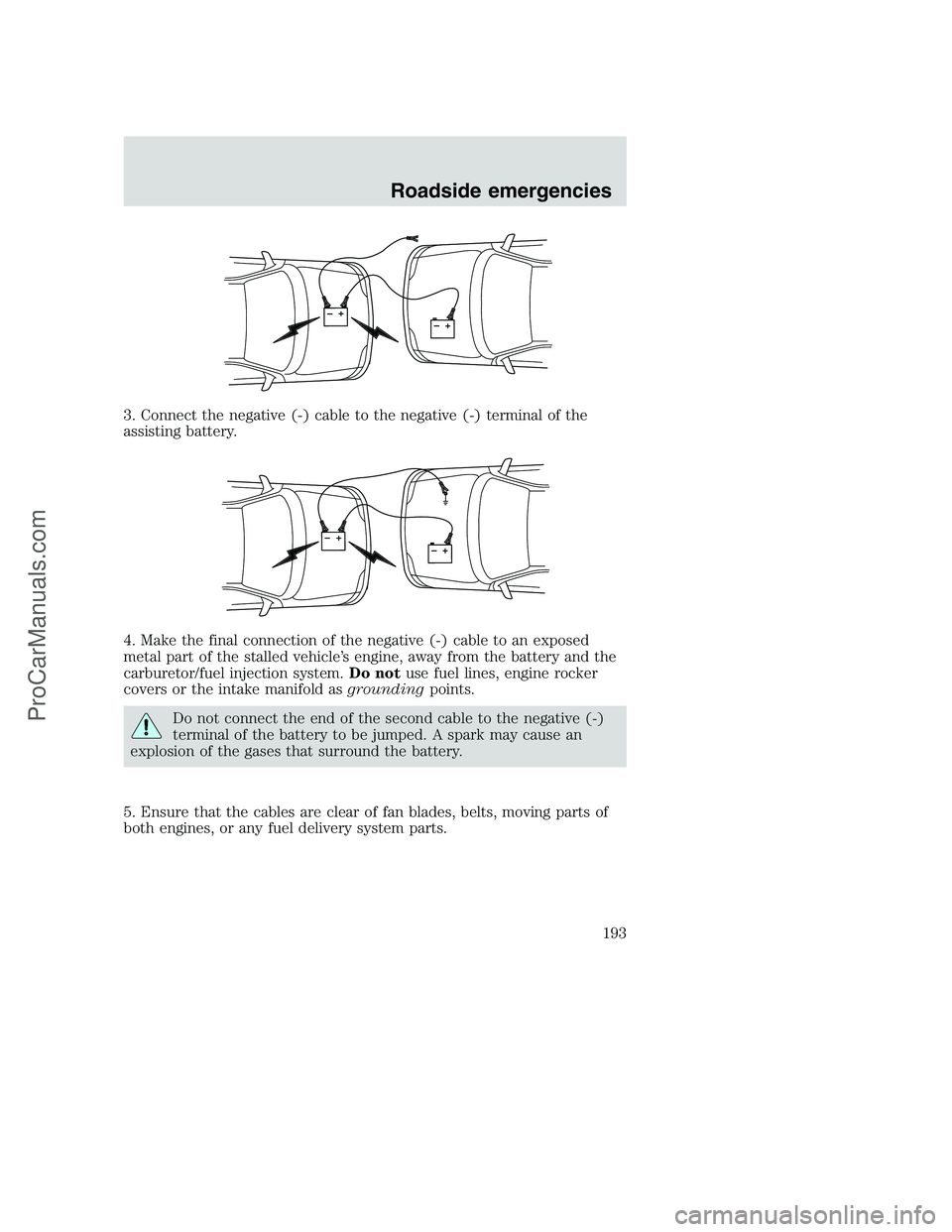
3. Connect the negative (-) cable to the negative (-) terminal of the
assisting battery.
4. Make the final connection of the negative (-) cable to an exposed
metal part of the stalled vehicle’s engine, away from the battery and the
carburetor/fuel injection system.Do notuse fuel lines, engine rocker
covers or the intake manifold asgroundingpoints.
Do not connect the end of the second cable to the negative (-)
terminal of the battery to be jumped. A spark may cause an
explosion of the gases that surround the battery.
5. Ensure that the cables are clear of fan blades, belts, moving parts of
both engines, or any fuel delivery system parts.
+–+–
+–+–
Roadside emergencies
193
ProCarManuals.com
Page 196 of 288
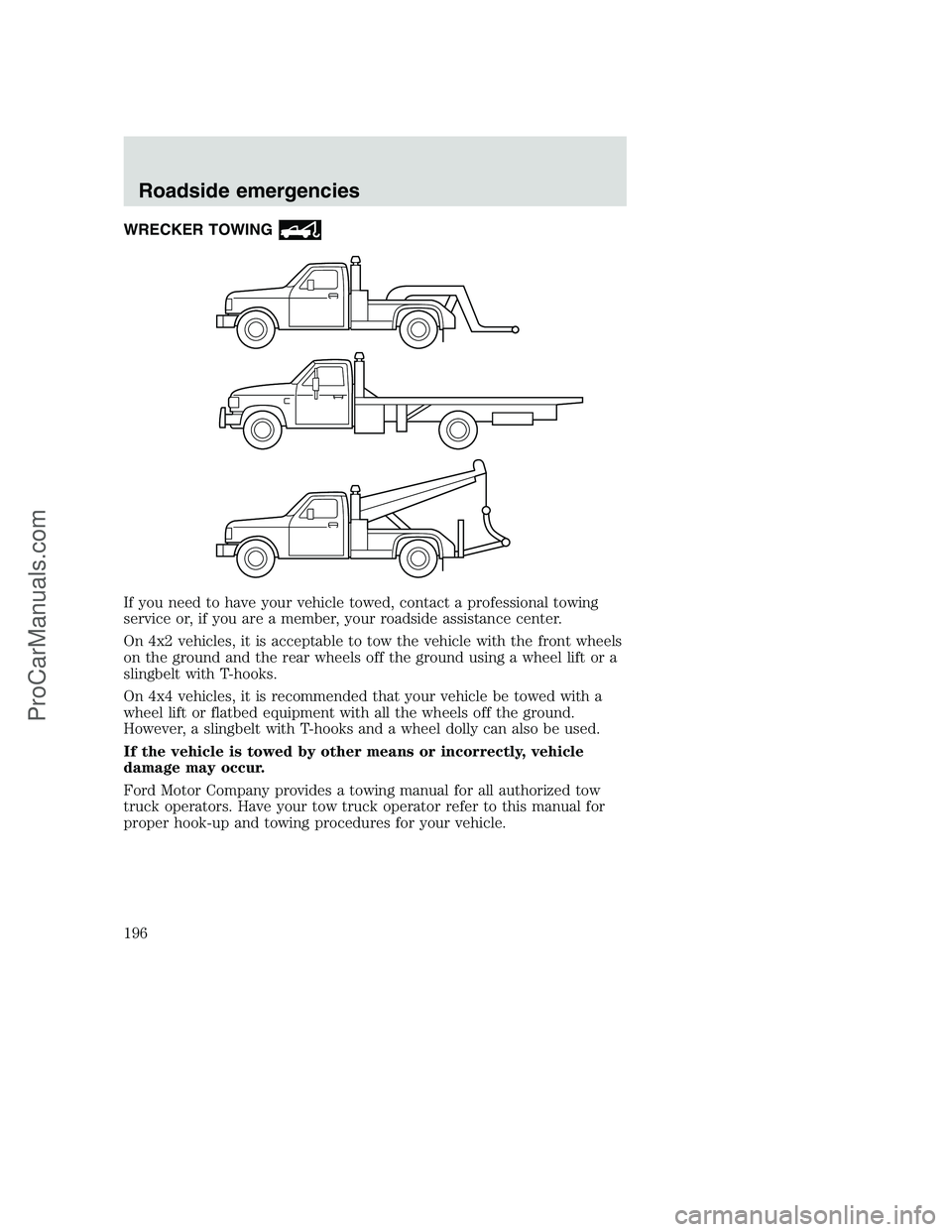
WRECKER TOWING
If you need to have your vehicle towed, contact a professional towing
service or, if you are a member, your roadside assistance center.
On 4x2 vehicles, it is acceptable to tow the vehicle with the front wheels
on the ground and the rear wheels off the ground using a wheel lift or a
slingbelt with T-hooks.
On 4x4 vehicles, it is recommended that your vehicle be towed with a
wheel lift or flatbed equipment with all the wheels off the ground.
However, a slingbelt with T-hooks and a wheel dolly can also be used.
If the vehicle is towed by other means or incorrectly, vehicle
damage may occur.
Ford Motor Company provides a towing manual for all authorized tow
truck operators. Have your tow truck operator refer to this manual for
proper hook-up and towing procedures for your vehicle.
Roadside emergencies
196
ProCarManuals.com
Page 225 of 288

•Five tire rotation
Replacing the tires
Replace the tires when the wear
band is visible through the tire
treads.
When replacing full size tires, never mix radial bias-belted, or
bias-type tires. Use only the tire sizes that are listed on the
Certification Label. Make sure that all tires are the same size, speed
rating, and load-carrying capacity. Use only the tire combinations
recommended on the label. If you do not follow these precautions,
your vehicle may not drive properly and safely.
Make sure that all replacement tires are of the same size, type,
load-carrying capacity and tread design (e.g., “All Terrain”, etc.),
as originally offered by Ford.
Maintenance and care
225
ProCarManuals.com
Page 248 of 288
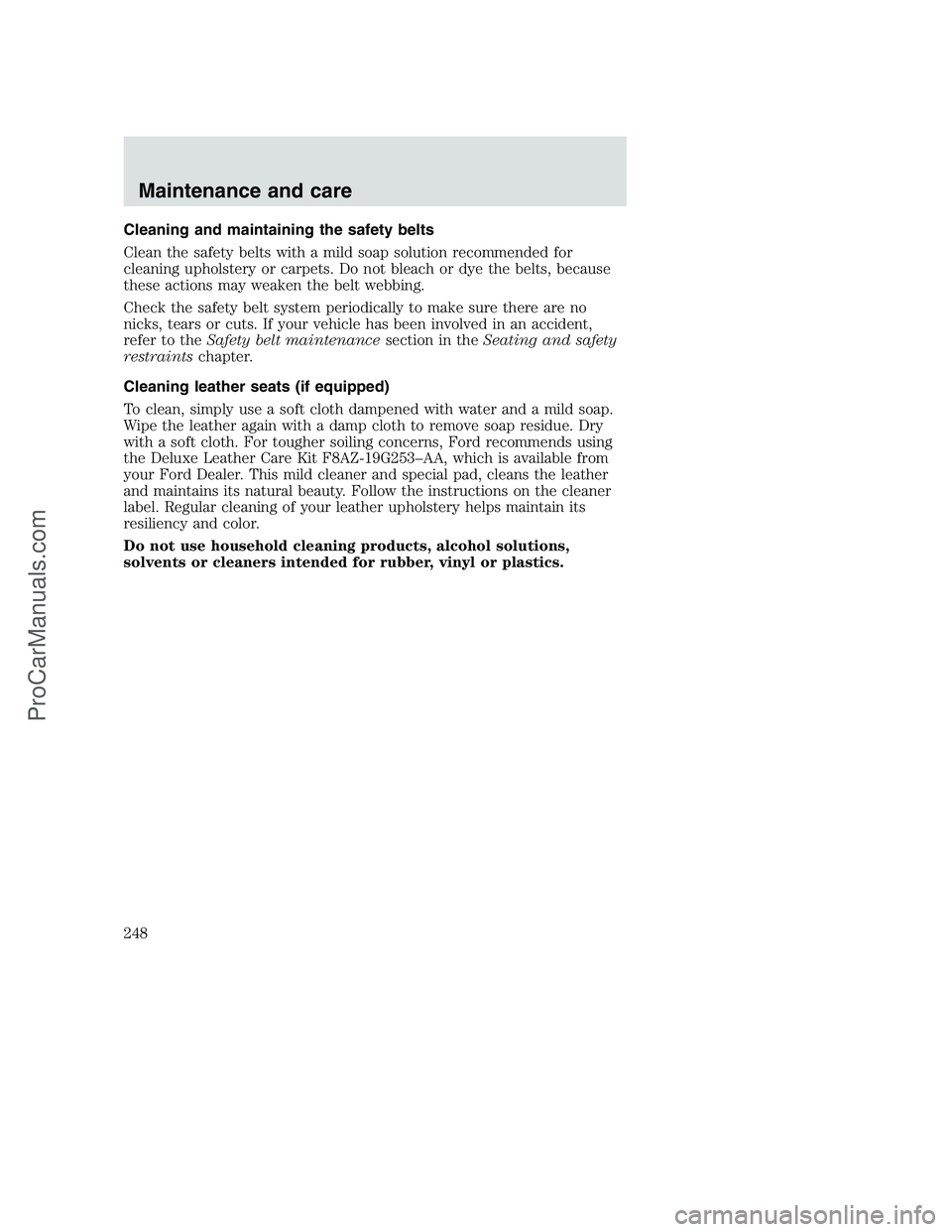
Cleaning and maintaining the safety belts
Clean the safety belts with a mild soap solution recommended for
cleaning upholstery or carpets. Do not bleach or dye the belts, because
these actions may weaken the belt webbing.
Check the safety belt system periodically to make sure there are no
nicks, tears or cuts. If your vehicle has been involved in an accident,
refer to theSafety belt maintenancesection in theSeating and safety
restraintschapter.
Cleaning leather seats (if equipped)
To clean, simply use a soft cloth dampened with water and a mild soap.
Wipe the leather again with a damp cloth to remove soap residue. Dry
with a soft cloth. For tougher soiling concerns, Ford recommends using
the Deluxe Leather Care Kit F8AZ-19G253–AA, which is available from
your Ford Dealer. This mild cleaner and special pad, cleans the leather
and maintains its natural beauty. Follow the instructions on the cleaner
label. Regular cleaning of your leather upholstery helps maintain its
resiliency and color.
Do not use household cleaning products, alcohol solutions,
solvents or cleaners intended for rubber, vinyl or plastics.
Maintenance and care
248
ProCarManuals.com
Page 278 of 288

A
Accessory delay ..........................80
Air bag supplemental
restraint system ........................107
and child safety seats ............109
description ..............................107
disposal ....................................111
driver air bag ..........................109
indicator light ...................11, 111
operation .................................109
passenger air bag ...................109
passenger deactivation
switch ......................................112
Air cleaner filter .......217–218, 249
Air conditioning ..........................29
Ambulance packages ....................4
Antifreeze (see Engine
coolant) .....................................206
Anti-lock brake system
(see Brakes) ......................131–132
Audio system (see Radio) ...35, 56
Automatic transmission
driving an automatic
overdrive .................................137
fluid, adding ............................214
fluid, checking ........................214
fluid, refill capacities ..............249
fluid, specification ..................256
Auxiliary power point ...........29, 83
Axle
lubricant specifications ..253, 256
refill capacities ........................249
traction lok ..............................134
B
Battery .......................................219acid, treating emergencies .....219
charging system
warning light .............................13
jumping a disabled battery ....191
maintenance-free ....................219
replacement, specifications ...249
servicing ..................................219
voltage gauge ............................19
Belt minder ...............................103
Brakes ........................................131
anti-lock ...........................131–132
anti-lock brake system
(ABS) warning light .........13, 132
brake warning light ..................12
fluid, checking and adding ....204
fluid, refill capacities ..............249
fluid, specifications .........253, 256
lubricant specifications ..253, 256
parking ....................................133
pedals (see Power adjustable
foot pedals) ...............................26
shift interlock ..........................136
Break-in period .............................3
C
Capacities for refilling fluids ....249
Certification Label ....................261
Child safety restraints ..............117
child safety belts ....................117
Child safety seats ......................118
attaching with tether straps ..122
in front seat ............................119
in rear seat ..............................119
tether anchorage hardware ...122
Cleaning your vehicle ...............243
engine compartment ..............246
exterior ............................244–245
exterior lamps .........................246
Index
278
ProCarManuals.com
Page 279 of 288
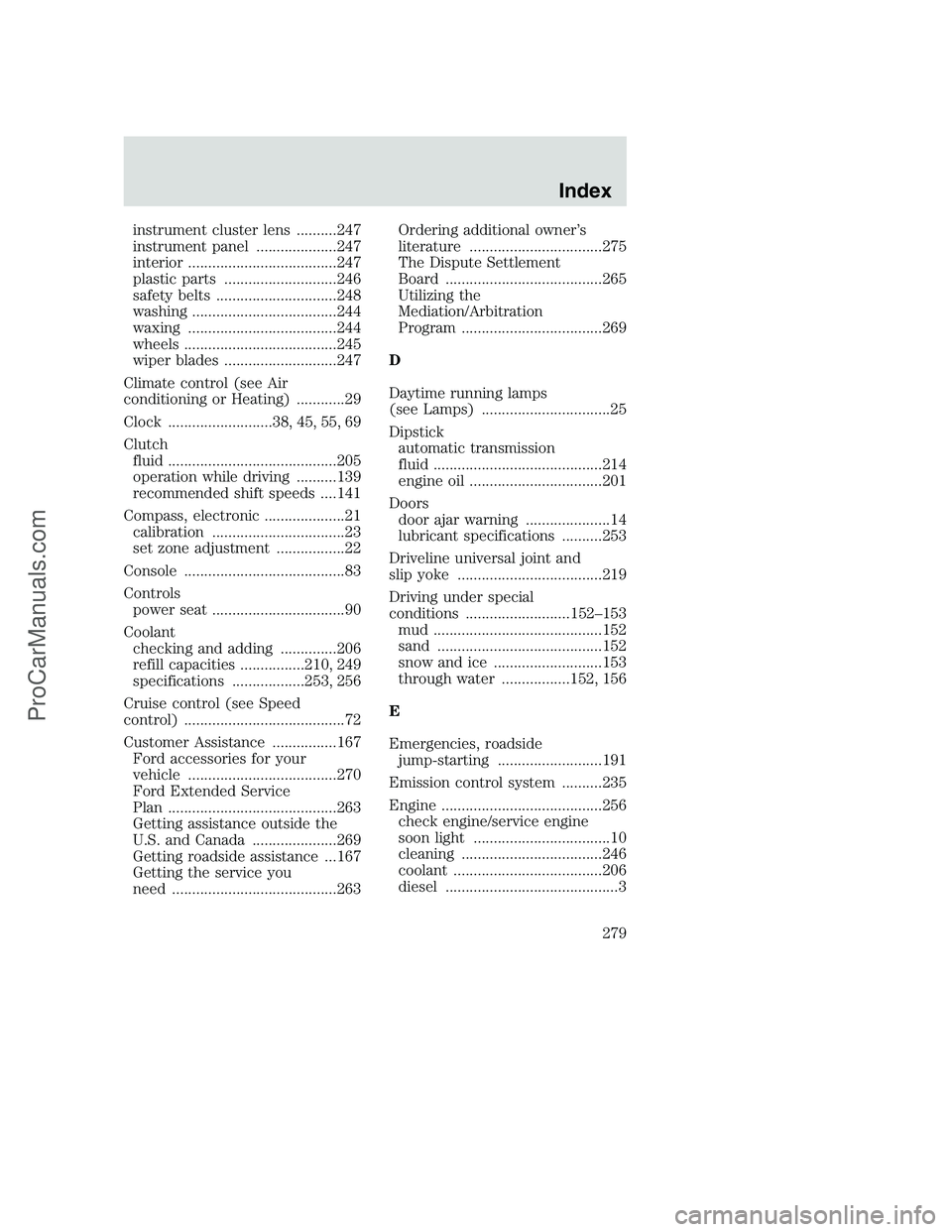
instrument cluster lens ..........247
instrument panel ....................247
interior .....................................247
plastic parts ............................246
safety belts ..............................248
washing ....................................244
waxing .....................................244
wheels ......................................245
wiper blades ............................247
Climate control (see Air
conditioning or Heating) ............29
Clock ..........................38, 45, 55, 69
Clutch
fluid ..........................................205
operation while driving ..........139
recommended shift speeds ....141
Compass, electronic ....................21
calibration .................................23
set zone adjustment .................22
Console ........................................83
Controls
power seat .................................90
Coolant
checking and adding ..............206
refill capacities ................210, 249
specifications ..................253, 256
Cruise control (see Speed
control) ........................................72
Customer Assistance ................167
Ford accessories for your
vehicle .....................................270
Ford Extended Service
Plan ..........................................263
Getting assistance outside the
U.S. and Canada .....................269
Getting roadside assistance ...167
Getting the service you
need .........................................263Ordering additional owner’s
literature .................................275
The Dispute Settlement
Board .......................................265
Utilizing the
Mediation/Arbitration
Program ...................................269
D
Daytime running lamps
(see Lamps) ................................25
Dipstick
automatic transmission
fluid ..........................................214
engine oil .................................201
Doors
door ajar warning .....................14
lubricant specifications ..........253
Driveline universal joint and
slip yoke ....................................219
Driving under special
conditions ..........................152–153
mud ..........................................152
sand .........................................152
snow and ice ...........................153
through water .................152, 156
E
Emergencies, roadside
jump-starting ..........................191
Emission control system ..........235
Engine ........................................256
check engine/service engine
soon light ..................................10
cleaning ...................................246
coolant .....................................206
diesel ...........................................3
Index
279
ProCarManuals.com